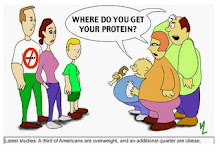1 - Human, 2 - Cow, 3 - Cat, 4 - Dog, 5 - Horse
Back to my anatomy lesson. Just because I can eat a double whopper with cheese, large order of french fries and a milk shake doesn't mean my body is designed to digest it efficiently. My belly aches thinking about it. I'm going to summarize below an article from Milton R. Mills, M.D. and include some facts about the anatomical and physical differences between herbivores and true carnivores. I encourage you to read his full article, go take a good look at your cat and discard your Paleo book.
Human teeth are also similar to those found in other herbivores with the exception of the canines (the canines of some of the apes are elongated and are thought to be used for display and/or defense). Our teeth are rather large and usually abut against one another. The incisors are flat and spade-like, useful for peeling, snipping and biting relatively soft materials. The canines are neither serrated nor conical, but are flattened, blunt and small and function Like incisors. The premolars and molars are squarish, flattened and nodular, and used for crushing, grinding and pulping noncoarse foods.
Human saliva contains the carbohydrate-digesting enzyme, salivary amylase. This enzyme is responsible for the majority of starch digestion. The esophagus is narrow and suited to small, soft balls of thoroughly chewed food. Eating quickly, attempting to swallow a large amount of food or swallowing fibrous and/or poorly chewed food (meat is the most frequent culprit) often results in choking in humans.
Man's stomach is single-chambered, but only moderately acidic. (Clinically, a person presenting with a gastric pH less than 4-5 when there is food in the stomach is cause for concern.) The stomach volume represents about 21-27% of the total volume of the human GI tract. The stomach serves as a mixing and storage chamber, mixing and liquefying ingested foodstuffs and regulating their entry into the small intestine. The human small intestine is long, averaging from 10 to 11 times the body length. (Our small intestine averages 22 to 30 feet in length. Human body size is measured from the top of the head to end of the spine and averages between two to three feet in length in normal-sized individuals.)
The human colon demonstrates the pouched structure peculiar to herbivores. The distensible large intestine is larger in cross-section than the small intestine, and is relatively long. Man's colon is responsible for water and electrolyte absorption and vitamin production and absorption. There is also extensive bacterial fermentation of fibrous plant materials, with the production and absorption of significant amounts of food energy (volatile short-chain fatty acids) depending upon the fiber content of the diet. The extent to which the fermentation and absorption of metabolites takes place in the human colon has only recently begun to be investigated.
In conclusion, we see that human beings have the gastrointestinal tract structure of a “committed” herbivore. Humankind does not show the mixed structural features one expects and finds in anatomical omnivores such as bears and raccoons. Thus, from comparing the gastrointestinal tract of humans to that of carnivores, herbivores and omnivores we must conclude that humankind's GI tract is designed for a purely plant-food diet.
One of the best things you can do for your health is go vegan. Feel free to read my other posts and join me on my journey.











 So let me bring some light to the word "Enlightenment".
So let me bring some light to the word "Enlightenment". 